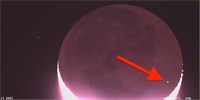On Saturday, March 25, asteroid 2023 DZ2 will pass by our planet. A body about seventy meters in size will be at its closest point roughly half the Earth-Moon distance. Closest approach is expected to occur around 19:51 UTC (20:51 CET). Exact time and other details may be updated in light of ongoing observations, reports the EarthSky website.
2023 DZ2 is classified as a near-Earth object of the Apollo group. It is therefore an asteroid that has an orbit similar to the orbit of the Earth and can therefore get very close to it. It was discovered on February 27 this year by astronomers Ovidiu Vaduvescu, Freya Barwell and Kiran Jhass using the Isaac Newton Telescope at the Roque de los Muchachos Observatory on La Palma in the Canary Islands.
Asteroid 2023 DZ2
According to findings so far will fly by at a distance of 174,645 ± 66 kilometers from our planet and should be visible even with amateur intermediate telescopes and telescopes equipped with an image sensor. From March 20 to 24, 2023, it will move (as seen from Earth) in the constellation of Cancer. It will brighten to apparent magnitude 9.9 on March 25 at around 6:20 p.m., but even then it won’t be visible to the naked eye.
The asteroid moves along an eccentric orbit and during one orbit, lasting 3.16 years, is at its closest point 0.5 to 0.8 astronomical units (about 75 to 120 million kilometers) from the Sun. On the contrary, at its farthest point it is three times farther from the Sun than the Earth – it reaches a distance of up to 3.32 astronomical units (about 497 million kilometers).
Our planet’s gravitational field will affect the asteroid’s orbit, shortening its orbital period to 3.007 years. On April 4, 2023, it will reach perihelion, i.e. the closest approach to the Sun. Initial observations suggested there was a very small chance (with a 1 in 430 chance) that it could hit Earth on March 27, 2026, however further measurements refuted this assumption.
An opportunity for scientific research
The object moves with respect to the Earth at a speed of 28,008 km/h, i.e. 7.78 km/second. While that might sound like a huge speed—at least from what we know from Earth—compared to other asteroids that astronomers study, it’s a relatively slow object.
A close encounter with such a large asteroid does not happen very often, so astronomers are understandably on high alert. “While close approaches are a regular occurrence, a close flyby of an asteroid of this size (140-310 feet) occurs only about once every ten yearswhich represents a unique opportunity for scientific research.” NASA said on Twitter.
You can track the movement of asteroid 2023 DZ2 in real time via the website NASA Eyes on Asteroids – a powerful 3D visualization tool that tracks all known asteroids in our solar system.



